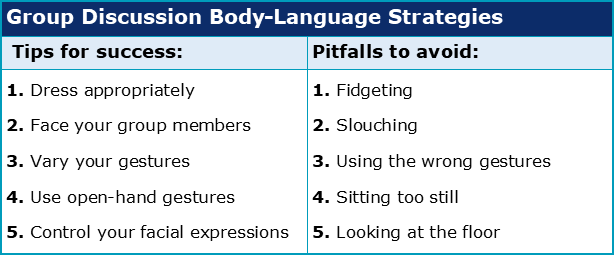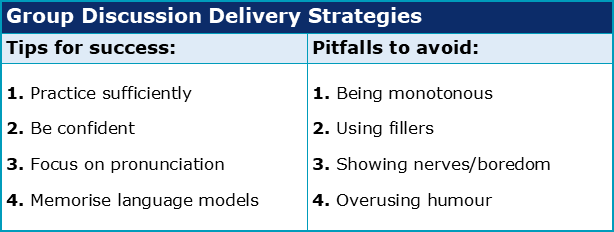Which skills make for effective group discussions?

This is the second of three chapters about Group Discussions. To complete this reader, read each chapter carefully and then unlock and complete our materials to check your understanding.
– Discuss the key skills that make for effective group discussions
– Provide example strategies for body language, delivery, discussion language, interaction and preparation
– Offer activities to check progress and understanding
Chapter 2

While the first chapter on group discussions explored the overall purpose and various assessment criteria for this type of academic assignment, this second chapter now focuses on the five key areas that make for effective discussions. These areas are body language, delivery strategies, discussion strategies, interaction strategies and preparation.
1. Body language
The first skill that students should focus on improving when delivering assessed group discussions is body language. This may include:
- Gestures = such as using open hands to point towards another group member
- Eye Contact = how the presenter uses their eyes to incorporate other speakers
- Postures = whether sitting straight, spreading the legs, leaning or slouching
- Positioning = how the listener turns to face those who are speaking
- Facial Expressions = such as a smile, a raised eyebrow or a furrowed brow

2. Delivery strategies
In addition to body language, students should also pay attention to delivery strategies when conducting group discussions. Many of the same strategies that are useful for conducting academic assessed presentations are also useful here:

3. Discussion language
It’s important that students also remember to include useful language structures during a group discussion as these structures help to signpost the various sections and elements of a debate. While our experts have created an entire reader on discussion strategies that students may wish to study, the key areas are highlighted below:
Agreeing and disagreeing:
- That is a very good point.
- I understand what you mean, but…
Clarification and elaboration:
- Could you explain what you mean by…
- Why do you think this is the case?
- What I meant by that is…
Defining terminology:
- It might be a good idea to explain what (x) means at this point.
- Before continuing, we should define the meaning of (X).
Explaining the question:
- What we’ve been tasked with discussing today is (x).
- Today’s discussion is on the topic of (X).
Giving examples and opinions:
- One example of this might be…
- What I think is that…
- In my opinion…
Referring to sources:
- X argues that…
- I read an article about (x) that mentioned…
- In a presentation I watched about (X)…
Summarising and concluding:
- To sum up today’s discussion…
- Let’s remind ourselves of the main points from today’s talk…
4. Interaction strategies
In addition to the above language structures, there are a number of interaction strategies that student’s should also understand and rehearse. For example, students should make sure that each participant in their discussion has an equal amount of time to speak. Any student that talks too much or too little will likely have their grade reduced by their assessor as they will be insufficiently fulfilling the task.

Additionally, students should remember to show that they are listening carefully. An effective group discussion is one in which all members are thoughtfully responding to each other’s comments and suggestions, providing appropriate responses and supporting information that builds upon and furthers the debate. When participating in this manner, students should also remember to be polite at all times, introducing background knowledge in a friendly, open and objective way and responding to others patiently and positively.
5. Preparation
To demonstrate sufficient background knowledge in a group discussion, students will require ample preparation. If a student wishes to score highly, they should make sure they read up on course materials and remain up-to-date with relevant topical information. To do this may involve studying a number of books, newspapers and websites about any events that may provide supporting information for a possible discussion topic. Students should also attempt to formulate opinions about these events, considering arguments and counter-arguments so that they can debate a topic from both sides. Students may even wish to practise debating these topics with friends and family before the discussion to improve fluency and confidence.
Well done on completing this second chapter about group discussions. You should next complete the related Chapter 2 activities to check your progress and understanding before moving on to Chapter 3. This final chapter focuses on nine common pitfalls that students should avoid when completing this assessment type.
To reference this reader:
Academic Marker (2022) Group Discussions. Available at: https://academicmarker.com/academic-guidance/assignments/group-discussions/ (Accessed: Date Month Year).
Downloadables
Once you’ve completed all three chapters in this short reader about Group Discussions, you might then wish to download our Chapter Worksheets to check your progress or print for your students. These professional PDF worksheets can be easily accessed for only a few Academic Marks.
Chapter 1 explores the topic: What is an assessed academic group discussion? Our Chapter 1 Worksheet (containing guidance, activities and answer keys) can be accessed here at the click of a button.
Chapter 2 explores the topic: Which skills make for effective group discussions? Our Chapter2 Worksheet (containing guidance, activities and answer keys) can be accessed here at the click of a button.
Chapter 3 explores the topic: What are the nine pitfalls of university discussions? Our Chapter 3 Worksheet (containing guidance, activities and answer keys) can be accessed here at the click of a button.
To save yourself 2 Marks, click on the button below to gain unlimited access to all of our Group Discussions Chapter Worksheets. This All-in-1 Pack includes every chapter, activity and answer key related to this topic in one handy and professional PDF.
Collect Academic Marks
-
100 Marks for joining
-
25 Marks for daily e-learning
-
100-200 for feedback/testimonials
-
100-500 for referring your colleages/friends